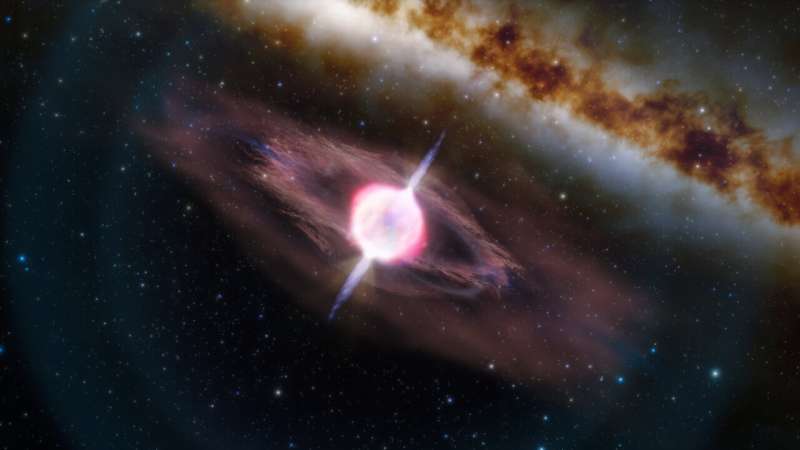Astronomers uncover briefest supernova-powered gamma-ray burst

Astronomers have discovered the shortest-ever gamma-ray burst (GRB) caused by the implosion of a massive star. Using the international Gemini Observatory, a program of NSF's NOIRLab, astronomers identified the cause of this 0.6-second flurry of gamma rays as a supernova explosion in a distant galaxy. GRBs caused by supernovae are usually more than twice as long, which suggests that some short GRBs might actually be imposters—supernova-produced GRBs in disguise.
Gamma-ray bursts (GRBs) are among the brightest and most energetic events in the universe, but scientists are still figuring out exactly what causes these fleeting events. Astronomers divide GRBs into two broad categories based on their duration. Short GRBs blaze into life in less than two seconds and are thought to be caused by the merging of binary neutron stars. Those that last longer are classified as long GRBs, and have been associated with supernova explosions caused by the implosions of massive stars. However, the recent discovery of the shortest-ever GRB produced during a supernova shows that GRBs don't fit neatly into the boxes astronomers have created for them.
"This discovery represents the shortest gamma-ray emission caused by a supernova during the collapse of a massive star," commented Tomás Ahumada, who led this research and is a Ph.D. candidate at the University of Maryland and astronomer at NASA's Goddard Space Flight Center. "It lasted for only 0.6 second, and it sits on the brink between a successful and a failed gamma-ray burst."
The team believes that this and some other supernova-related GRBs are appearing short because the jets of gamma rays that emerge from the collapsing star's poles aren't strong enough to completely escape the star—almost failing to produce a GRB—and that other collapsing stars have such weak jets that they don't produce GRBs at all.
This discovery could also help explain an astronomical mystery. Long GRBs are associated with a specific type of supernova (called Type Ic-BL). However, astronomers observe many more of these supernovae than long GRBs. This discovery of the shortest GRB associated with a supernova suggests that some of these supernova-caused GRBs are masquerading as short GRBs thought to be created by neutron-star mergers, and are therefore not getting counted as the supernova kind.
"Our discovery suggests that, since we observe many more of these supernovae than long gamma-ray bursts, most collapsing stars fail to produce a GRB jet that breaks through the outer envelope of the collapsing star," explained Ahumada. "We think this event was effectively a fizzle, one that was close to not happening at all."
The team was able to determine that this GRB—identified as GRB 200826A—originated from a supernova explosion thanks to the imaging capabilities of the Gemini Multi-Object Spectrograph on Gemini North in Hawai'i. The researchers used Gemini North to obtain images of the GRB's host galaxy 28, 45, and 80 days after the GRB was first detected on 26 August 2020 by a network of observatories that included NASA's Fermi Gamma-ray Space Telescope. Gemini's observations allowed the team to spot the tell-tale rise in energy that signifies a supernova, despite the blast's location in a galaxy 6.6 billion light-years away.
"This was a complicated endeavor as we needed to separate the light of an already faint galaxy from the light of a supernova," said Ahumada. "Gemini is the only ground-based telescope that can do follow-up observations like this with a flexible-enough schedule to let us squeeze in our observations."
This result shows that classifying GRBs based solely on their duration may not be the best approach, and that additional observations are needed to determine a GRB's cause.
"We were originally hunting for merging neutron stars, which are thought to produce short gamma-ray bursts," added Ahumada. "Once we discovered GRB 200826A, however, we realized that this burst was more likely to be caused by a collapsing star's supernova, which was a surprise."
"The Gemini observatories continue to shed new light on the nature of these incredible explosions occurring across the distant universe," said Martin Still, Gemini Program Officer at NSF. "Dedicated instrumentation arriving for use over the next decade will maintain Gemini's leadership in the follow-up of these awe-inspiring cosmic events."
More information: Discovery and confirmation of the shortest gamma ray burst from a collapsar, arXiv:2105.05067 [astro-ph] arxiv.org/abs/2105.05067
Provided by NOIRLab





















